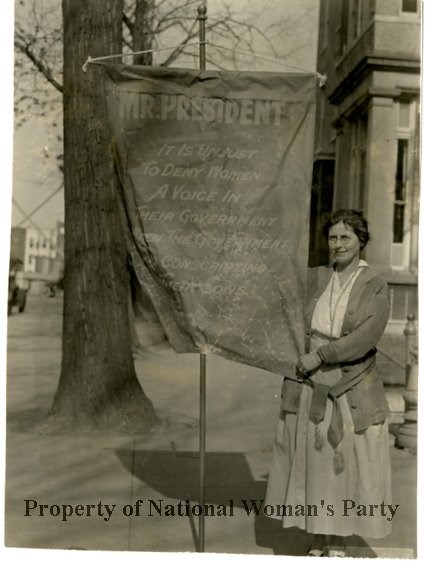Last updated: September 1, 2020
Article
National Woman's Party Protests During World War I
"MR. PRESIDENT
IT IS UNJUST TO DENY WOMEN A VOICE IN THEIR GOVERNMENT WHEN THE GOVERNMENT IS CONSCRIPTING THEIR SONS"
What is the role of political dissent during wartime?

National Woman's Party
On June 20, 1917, National Woman’s Party (NWP) co-founder Lucy Burns took up her position on the sidewalk in front of the White House entry gate. Burns and NWP member Dora Lewis held between them a large banner addressed “To the Envoys of Russia.” The banner accused President Woodrow Wilson of deceiving the Russians when he claimed that the two countries were fighting to preserve democracy. “We, the Women of America, tell you that America is not a democracy,” the banner read. “Twenty million American Women are denied the right to vote. President Wilson is the chief opponent of their national enfranchisement.” The Russian delegation saw the banner as their car passed through the White House gate on their way to meet with the president.
The National Woman’s Party had organized pickets of the White House for six days a week, in all kinds of weather, since January 10, 1917. The “Silent Sentinels” as they were known showed up each day holding banners demanding the right to vote for American women. Rather than pursue enfranchisement state by state, as the National American Women’s Suffrage Association (NAWSA) was doing, the NWP focused their efforts on the passage of an amendment to the U.S. Constitution. The amendment, named for Susan B. Anthony and first introduced in 1878, stated that “The right of citizens of the United States to vote shall not be denied or abridged by the United States or by any State on account of sex.”

National Woman's Party
The NWP strategy to promote passage of the Anthony Amendment included pressuring President Wilson to support it. Presidents have no role in amending the Constitution, but NWP leader Alice Paul believed that Wilson’s endorsement would sway members of Congress from the Democratic Party to vote for the amendment’s passage. Their efforts had only managed to push Wilson to offer tepid support for women’s suffrage eventually, although he asked for patience, chiding American women that “you can afford a little while to wait.”
During their months of picketing, the women often held banners echoing Wilson’s own words, such as:
“MR. PRESIDENT, YOU SAY LIBERTY IS THE FUNDAMENTAL DEMAND OF THE HUMAN SPIRIT.”
and
“MR. PRESIDENT, HOW LONG MUST WOMEN WAIT FOR LIBERTY?”
Once the United States entered the war in Europe, many in the women’s suffrage movement believed that their lobbying and activism should be put on hold. The leaders of the National Woman’s Party, however, decided to continue the demonstrations. Public opinion turned against the Silent Sentinels, who were now seen as unpatriotic.
Rather than back down, the NWP decided to become more confrontational. Onlookers became increasingly more hostile to the picketers. On that June day when Lucy and Dora raised the provocative banner addressing the Russians, the anger boiled over. Crowds ripped the banner out of the hands of the picketers and off its poles. The next day, picketers returned, this time with a banner quoting Wilson.
“WE SHALL FIGHT FOR THE THINGS WE HAVE ALWAYS HELD NEAREST TO OUR HEARTS.”
This time, the police tried to confiscate the banner. When the women refused, they were arrested.
Over the next several months, women continued to take up positions in front of the White House. They faced violence and arrest. More than 150 women were convicted of obstructing traffic for their protest. They served jail time rather than pay what they considered unjust fines for exercising their constitutional rights. As picketing and arrests continued, the sentences increased from a few days in the District Jail to several months in the Occoquan Work House in Virginia. The women, many of whom came from prominent and politically connected families, demanded to be treated as political prisoners. They went on hunger strikes to protest their conditions and many were violently force-fed.
Among the hunger strikers was NWP leader Alice Paul, arrested on October 20, 1917 carrying a banner that read:
“THE TIME HAS COME TO CONQUER OR SUBMIT. FOR US, THERE IS BUT ONE CHOICE. WE HAVE MADE IT.”
The slogan, adapted from Woodrow Wilson’s own words, was used throughout the country on posters supporting the war effort. Alice Paul declared her own war against injustice by co-opting the battle cry for the cause of women’s suffrage. As she declared in 1919:
“When men are denied justice, they go to war. This is our war, only we are fighting it with banners instead of guns.”
National Parks and the Great War
World War ITags
- belmont-paul women's equality national monument
- national mall and memorial parks
- the white house and president's park
- wwi
- politics
- womens suffrage
- suffrage
- protest
- anti-war
- society
- picketing
- civil rights
- women's rights
- womens rights
- 19th amendment
- 19th amendment centennial
- 19th amendment commemoration countdown
- belmont-paul
- national mall and memorial parks
